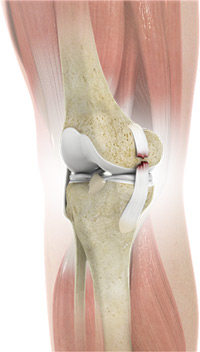MCL Tears

What is a Medial Collateral Ligament Tear?
The medial collateral ligament (MCL) is the ligament that is located on the inner part of the knee joint. It runs from the femur (thighbone) to the top of the tibia (shinbone) and helps in stabilizing the knee.
Causes of Medial Collateral Ligament Tears
Medial collateral ligament (MCL) injury can result in a stretch, partial tear, or complete tear of the ligament. Injuries to the MCL commonly occur because of a pressure or stress on the outside part of the knee. Anterior cruciate ligament (ACL) may be torn along with an MCL injury.
Symptoms of Medial Collateral Ligament Tears
Patients with an MCL tear have symptoms such as knee pain, swelling, and locking or catching sensation in the knee during movement. Patients may also feel as though their knee may 'give out' suddenly or buckle.
Diagnosis of Medial Collateral Ligament Tears
Your doctor will usually diagnose an MCL injury based on a physical examination of your knee. To determine looseness of the ligament, an MCL test may be performed by exerting pressure on the outside of your knee while your knee is bent to 25 degrees. In addition, other tests such as knee joint X-rays and MRI scan may be done.
Treatment of Medial Collateral Ligament Tears
Treatment options include non-surgical and surgical treatment. Non-surgical treatment consists of rest, ice, compression, and elevation (RICE protocol); all assist in controlling pain and swelling. A knee brace may be worn to help immobilize your knee. Use of crutches may be recommended to protect your knee and to keep you from putting weight on your knee while walking. Physiotherapy exercises may be recommended to improve knee motion and strength.
Most often, surgery is not necessary for the treatment of an MCL tear. Grade 2 or 3 injuries are usually treated in a brace.
Occasionally surgery is indicated when the MCL is ruptured off the tibia and displaced. The MCL may also be repaired with a multi-ligament injury.



